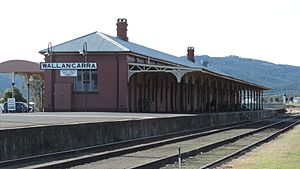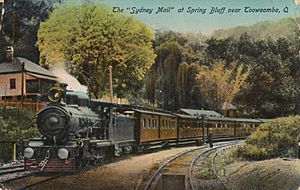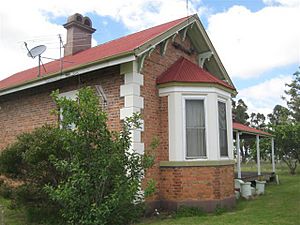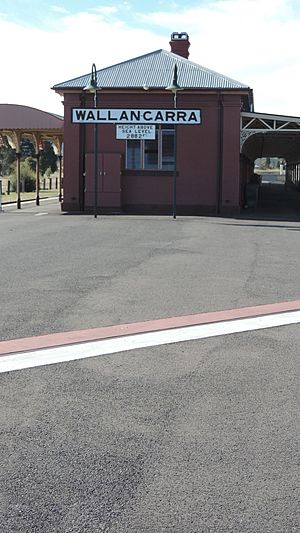Wallangarra railway station facts for kids
Quick facts for kids
|
|||||||||||
|---|---|---|---|---|---|---|---|---|---|---|---|
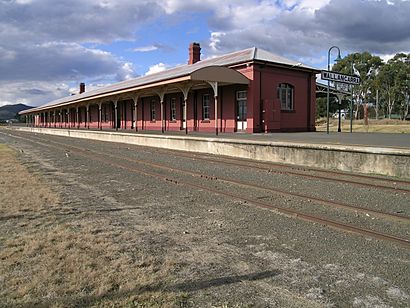
Queensland platform (western side), May 2008
|
|||||||||||
| Location | Rockwell Street, Wallangarra | ||||||||||
| Coordinates | 28°55′24″S 151°55′55″E / 28.9232°S 151.9319°E | ||||||||||
| Elevation | 878 metres (2,881 ft) | ||||||||||
| Owned by | Queensland Rail | ||||||||||
| Operated by | Traveltrain | ||||||||||
| Line(s) | Main Northern (New South Wales) Southern (Queensland) |
||||||||||
| Distance | 792.81 kilometres (492.63 mi) from Sydney 358.49 kilometres (222.76 mi) from Brisbane |
||||||||||
| Platforms | 2 (1 island) | ||||||||||
| Construction | |||||||||||
| Structure type | Ground | ||||||||||
| History | |||||||||||
| Opened | 4 February 1887 | ||||||||||
| Services | |||||||||||
|
|||||||||||
| Lua error in Module:Location_map at line 420: attempt to index field 'wikibase' (a nil value). | |||||||||||
| Location | Woodlawn Street, Wallangarra, Southern Downs Region, Queensland, Australia | ||||||||||
| Design period | 1870s - 1890s (late 19th century) | ||||||||||
| Built | 1887 - 1890s circa | ||||||||||
| Official name: Wallangarra Railway Station and Complex | |||||||||||
| Type | state heritage (landscape, built) | ||||||||||
| Designated | 28 March 2003 | ||||||||||
| Reference no. | 601242 | ||||||||||
| Significant period | 1887-1972 (historical) | ||||||||||
| Significant components | railway siding, office/s, residential accommodation - station master's house/quarters, out building/s, yards - livestock, platform, railway station, furniture/fittings, loading bay/dock, views to | ||||||||||
| Builder | George Bashford | ||||||||||
The Wallangarra railway station is a very old train station located at Woodlawn Street in Wallangarra, Queensland, Australia. It was built in 1877 right on the border between Queensland and New South Wales. This station is so important that it's listed on the Queensland Heritage Register, which means it's a protected historical site.
Wallangarra station was once the only train link between Sydney and Brisbane. It was special because it had to handle a "break-of-gauge." This means the train tracks from Queensland were a different width (1,067 mm (3 ft 6 in)) than the tracks from New South Wales (1,435 mm (4 ft 8 1⁄2 in)). Passengers had to get off one train and onto another to continue their journey. For example, people travelling from Sydney would get off the Sydney Mail train and switch to the Brisbane Limited to go to Brisbane.
In 1930, a new train line was finished that went directly from Sydney to Brisbane using only one track width. This new line made the Wallangarra station less important. However, passenger trains still stopped at Wallangarra until February 1, 1972. After that, trains from Brisbane stopped at Toowoomba, and trains from Sydney stopped at Tenterfield.
Station History
Building the Border Station
The Wallangarra railway station officially opened on February 14, 1887. This happened when Queensland's Southern train line was extended from Stanthorpe to Wallangarra. A year later, on January 16, 1888, New South Wales also extended its Main Northern line from Tenterfield to Wallangarra. This created the first train link between Brisbane and Sydney.
Because the train tracks were different widths, the Wallangarra station was built right on the state border. It had one long platform with a building in the middle. The western side of the platform was for Queensland's narrower trains, and the eastern side was for New South Wales's wider trains. Each side of the building even had signs from its own railway company! The New South Wales side was first called Jennings, after the nearby town, but it eventually became known as Wallangarra too.
Early Railway Connections
Queensland's first railway line opened in 1865, connecting Ipswich to Bigges Camp. The goal was to link farming areas like the Darling Downs to the port at Ipswich. The railway slowly grew, reaching Toowoomba in 1867 and Dalby in 1868.
The Southern line, which went to Warwick, was approved in 1865 but faced money problems. It finally reached Warwick in 1871. This line took an indirect path to save money.
The Tin Rush and Railway Expansion
In 1871, tin was discovered near Stanthorpe, which brought many miners to the area. People wanted a train line to connect them to Brisbane and its port. A lot of goods were also moved across the border to New South Wales, and ore was sent to Brisbane for processing. Everyone hoped a railway would help Queensland get more of this trade.
Surveys for a railway from Warwick to Stanthorpe began in 1873. Building a line through the Granite Belt was difficult and expensive. More surveys were done in 1876 and 1877, extending all the way to the Queensland/New South Wales border. Finally, in August 1877, building the line from Warwick to Stanthorpe was approved. It was finished in 1881.
Planning the Border Meeting Point
In 1878, Queensland railway engineer Henry Charles Stanley talked with New South Wales officials. They planned a route for a future train connection between the two states. They agreed on a route that followed an old road from Stanthorpe to Tenterfield, with a border crossing point at what would become Wallangarra. In May 1878, surveyors from both states agreed that the best place for the two railways to meet was right on the border at Wallangarra.
In 1884, Queensland decided to extend its line from Stanthorpe to the border. Queensland's chief railway engineer, Stanley, went to Sydney to discuss designs for the border station. Since Queensland's railway was closer to the border, it was agreed that Queensland would build the station, and New South Wales would help pay for it.
In April 1885, a company called George Bashford and Company won the contract to build the railway extension to the border. It was expected to be finished by June 1887. In May 1885, the Queensland Government started selling land in the new border town of Wallangarra. The land sales were very successful!
The Debate Over the Meeting Point
In February 1886, Queensland gave New South Wales the plans for the Wallangarra station, which cost £28,000. But New South Wales thought it was too expensive. The Premier of New South Wales, Patrick Jennings, then suggested that Tenterfield, not Wallangarra, should be the meeting point for the two railways. Many people in New South Wales supported Tenterfield because it was an established town, while Wallangarra was described as "nothing but a desolate wilderness." Even some in Queensland thought Tenterfield would be better for trade.
However, Queensland continued building the railway to Wallangarra as originally planned. On February 14, 1887, the Queensland railway line reached the border. In May 1887, Premier Parkes of New South Wales finally agreed that his predecessor had already committed New South Wales to Wallangarra as the meeting point.
The New South Wales government finished its railway line to Wallangarra station in January 1888. The first Brisbane-to-Sydney train service left Brisbane on January 17, 1888.
Life at the Border Station
The Wallangarra railway station, with its train changing point and yards, led to the creation of two towns on the border: Wallangarra in Queensland and Jennings in New South Wales. A few years after the station opened, Wallangarra was described as a busy place with butchers, bakers, blacksmiths, and even a soda water factory.
The station building was on an island platform, with roofs (awnings) on both sides. The Queensland side had awnings with Queensland designs, and the New South Wales side had awnings with New South Wales designs. Both colonies also had their own style of name boards. The original station building had offices, a lobby, and a store. The booking office also served as a customs office and waiting room. Later, a bar, dining room, and kitchen were added. The Queensland/New South Wales border actually runs through the Station Master's property! The Station Master's house was special because it was built of brick, which was unusual for Queensland stations. A Post Office opened at the station in March 1887.
While Queensland always called the station Wallangarra, New South Wales kept changing its mind about the name. It was called Jennings three times before finally settling on Wallangarra in April 1904.
By 1884, the train between Brisbane and Stanthorpe was known as the "Mail" train, carrying mail. When the inter-state line opened in 1888, a regular train service called the "Sydney Mail" began between Sydney and Brisbane. This was the most important train service of its time. Over the years, the trains became more powerful and had more carriages.
Decline of Wallangarra's Importance
In 1921, a government group suggested that all train lines in Australia should have the same track width. As part of this plan, a new standard-width railway line was built between Sydney and Brisbane, going through Kyogle, New South Wales. This new line opened in 1930. It was a direct route and didn't need passengers to change trains at a border station. This meant Wallangarra's importance greatly decreased.
During World War II, Wallangarra became very important again. It was a key place for moving goods and supplies inland to defend Australia. Many workers were employed to transfer goods between the different sized trains. At this time, the station had many buildings, including offices, staff quarters, engine sheds, and yards for livestock. Most of these extra buildings are now gone.
The last "Sydney Mail" train ran on January 29, 1972. The Brisbane-Wallangarra passenger service stopped on February 1, 1972. The station's refreshment rooms closed in August 1973. After passenger services ended, the line was only used for freight. In 1988, the New South Wales line from Tenterfield to Wallangarra also closed.
Today, Queensland Rail stopped freight services to Wallangarra in March 2007. However, the station is still a popular spot for special steam train trips. Groups like Downs Explorer often run services from Warwick to Wallangarra.
Station Description
The Wallangarra station building is a long, single-story brick building with a sloped roof and iron verandahs. The Brisbane platform side has a curved iron roof, similar to other old Queensland stations. A small yard for preparing food for the refreshment rooms was next to the station. The New South Wales side's roof was built in 1890. The building has columns and arches, which show where the original lobby was. Inside, there were offices, a large kitchen, a dining room, and a bar.
The offices are at the south end of the building, and the refreshment rooms and post office (now empty) are at the north end. The station platform also has a special platform for loading horses at its southern end. The Queensland/New South Wales border crosses the platform about 2 meters north of this horse platform.
The Station Master's house faces the Sydney platform and is made of brick. It's an L-shaped house with a bay window, a reconstructed verandah, and decorative features on its gables and chimneys.
West of the station, there are two other buildings that were once used as living quarters for railway staff.
Heritage Importance
The Wallangarra Railway Station and its surrounding complex were added to the Queensland Heritage Register on March 28, 2003. This means it's recognized as a very important historical site.
Why is it Important?
- Shows how transport changed: The station and its train yard show how important train travel was in Queensland's history, especially in the late 1800s and early 1900s. It's a great example of how two different train systems from different colonies (states) met at a border because they had different track widths.
- It's a rare site: This complex is very rare. It's similar to other large border stations built around the same time, like Serviceton on the Victoria/South Australian border. The station building and the Station Master's house are also unusual in Queensland because they are made of brick.
- Shows key features of border stations: The station building and yard clearly show how a train station was designed to handle two different railway systems with different track widths meeting at a border.
Engineering Award
The station also received a special award called a Historic Engineering Marker from Engineers Australia. This award recognizes important engineering achievements.


